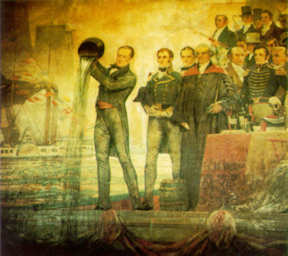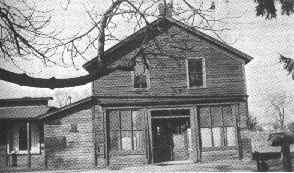|
THE ORIGINAL ERIE CANAL, constructed between 1817 and 1825, was 40 feet wide at the top, 28 feet at the bottom, 4 feet deep and 363 miles long from Albany to Buffalo. The difference in elevation from near sea
level on the Hudson River to 565 feet at Lake Erie was solved by building 83 locks, each 90 feet long and 15 feet wide. More than 300 bridges crossed the canal along its route. Mules and horses pulled the canal boats at 4 mph.
Costs to transport goods across the state on the canal were 80% to 90% lower than by road. Toll receipts on what had derisively been called "Clinton's Ditch" paid back the $7.5 million construction cost within ten
years. The canal was the most important element in the growth on New York's economy and population during the nineteenth century. THE ENLARGED ERIE CANAL, necessitated by increased traffic demands, was constructed from
1836 to 1862, in some places by widening and deepening the original, in others along a new course. Canal width at the top was increased to 70 feet, the bottom to 52 1/2
or 56 feet, and the depth to 7 feet. There were 72 doubled locks, measuring 110 by 18 feet, along the canal's 350 miles. Mules and horses remained the primary motive force, but the use of steam powered vessels increased in later years. Tolls were abolished in 1882 because of increasing competition from railroads.
A typical section of the second canal, and one side of a doubled lock, as they might have appeared around 1900, are shown on the Rail Barons exhibit. Very few of the old locks are preserved; the nearest are in
Lockport, used as spillways next to their 20th century replacements. THE BARGE CANAL SYSTEM
was begun in 1905 and completed in 1918, with a bottom width of 75 to 200 feet (the width at the top also varied) and minimum depth of 12 feet. Natural streams were used wherever possible. Animal power was totally replaced by steam or diesel. The Erie section, replacing the old canal, followed a 348 mile route from Tonawanda to Waterford. Its 35 new single locks were built 328 feet long by 28 feet wide with 11 foot sills.
Recently, the Thruway Authority has taken over the state's canals, tolls have been reintroduced, and the waterway connecting the Niagara and Hudson Rivers is again called the Erie Canal. Tourism and recreation have
become the primary reasons for the canal's continued existence and operation. This information was compiled for the Rail Barons, Buffalo & Erie County Historical Society. |

